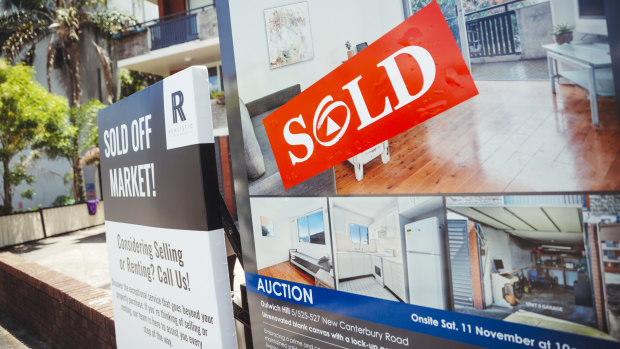This was published 8 months ago
RBA’s $200 billion stimulus powered house prices, not small business
By Shane Wright
A $188 billion Reserve Bank stimulus program did little for the small businesses it was intended to assist through the pandemic and instead helped turbocharge house prices as banks channelled the cash into cheap mortgages.
A review of the Reserve’s “term funding facility” program, which loaned money to commercial banks at an ultra-low interest rate of 0.1 per cent between March 2020 and June 2021, also found the bank lost $9 billion under the scheme as it raised rates.

Over one 12-month period during COVID, Sydney’s median house price was soaring by more than $800 a day.Credit: Dion Georgopoulos
The review backs the RBA’s handling of the program and argues it should be used in a future crisis but warns of the dangers of such large injections of cash into the economy, which contributed to the strength of the housing market.
Over one 12-month period during the pandemic, Sydney’s median house value climbed by $843 a day while Melbourne’s jumped by $473 a day.
Apart from taking official interest rates to a record low of 0.1 per cent, the bank undertook a range of measures – collectively termed quantitative easing – to help the economy through the COVID-era related shutdowns.
These included the program under which the RBA loaned $188 billion to commercial banks at 0.1 per cent, with extra cheap cash available if the banks loaned out the money to small businesses. More than 90 banks including the big four used the scheme, which was aimed at supporting the economy while also providing a boost to the small business sector.
But the review found overall lending to small business effectively didn’t change under the scheme with no “statistically significant effects” on credit growth to the sector.
“We also found no statistically significant effects on aggregate business credit growth for eligible banks that accessed the [funding facility] compared with banks that did not draw down,” it found.
Other state and federal schemes supported businesses around the same time, including the $90 billion JobKeeper and the $35 billion cash flow for employers schemes.
While small business lending failed to increase, in part due to the other government programs supporting the sector, fixed-rate mortgages soared during the scheme due to their interest rates falling by 1.52 percentage points in 2020. Over the same period, the cash rate fell by 0.65 percentage points.
The big fall in fixed rates led to a surge in the number of people on fixed mortgages. Before COVID, about 15 per cent of mortgages were on fixed rates. This climbed to 45 per cent by mid-2021.
Through this period, house values soared by more than 20 per cent across the country, the largest increase since the late 1980s.
The review conceded monetary policy “contributed to housing price growth over the pandemic period”, on top of other COVID-era housing stimulus measures and a shift by many Australians to larger homes or properties with extra rooms.
It noted home loan activity increased by more during COVID compared to any of the past five occasions the bank had cut interest rates.
“Though the cash rate decline during this period was the smallest of these episodes, it nevertheless reached a historically low level and the policy package reinforced the transmission of this to lending rates,” it found.
The review of the funding facility is the fourth investigation by the bank into various elements of its response to COVID. Each found issues.
RBA governor Michele Bullock now often says she is not engaging in the “forward guidance” on interest rates as her predecessor Philip Lowe did when he predicted rates would not rise until 2024.
Another review found the bank’s program of trying to keep government borrowing costs low had “caused some reputational damage”.
Apart from the hit to its reputation, the Reserve took a financial hit from the funding facility.
An unexpected turnaround in the economy, which forced the Reserve to lift interest rates much earlier – and to a higher level – than had been expected meant the scheme cost the RBA around $9 billion.
“It is difficult to quantify who received this benefit, but we estimate that much of it flowed to households and businesses that took out cheap fixed-rate loans,” the review found.
The bank, which releases its annual report later this month, has made accounting losses of almost $47 billion since COVID.
The federal government’s review of COVID-era policies, being conducted by former senior public servant Robyn Kruk, economist Angela Jackson and infectious diseases expert Professor Catherine Bennett, is due to report by October 25.
Cut through the noise of federal politics with news, views and expert analysis. Subscribers can sign up to our weekly Inside Politics newsletter.